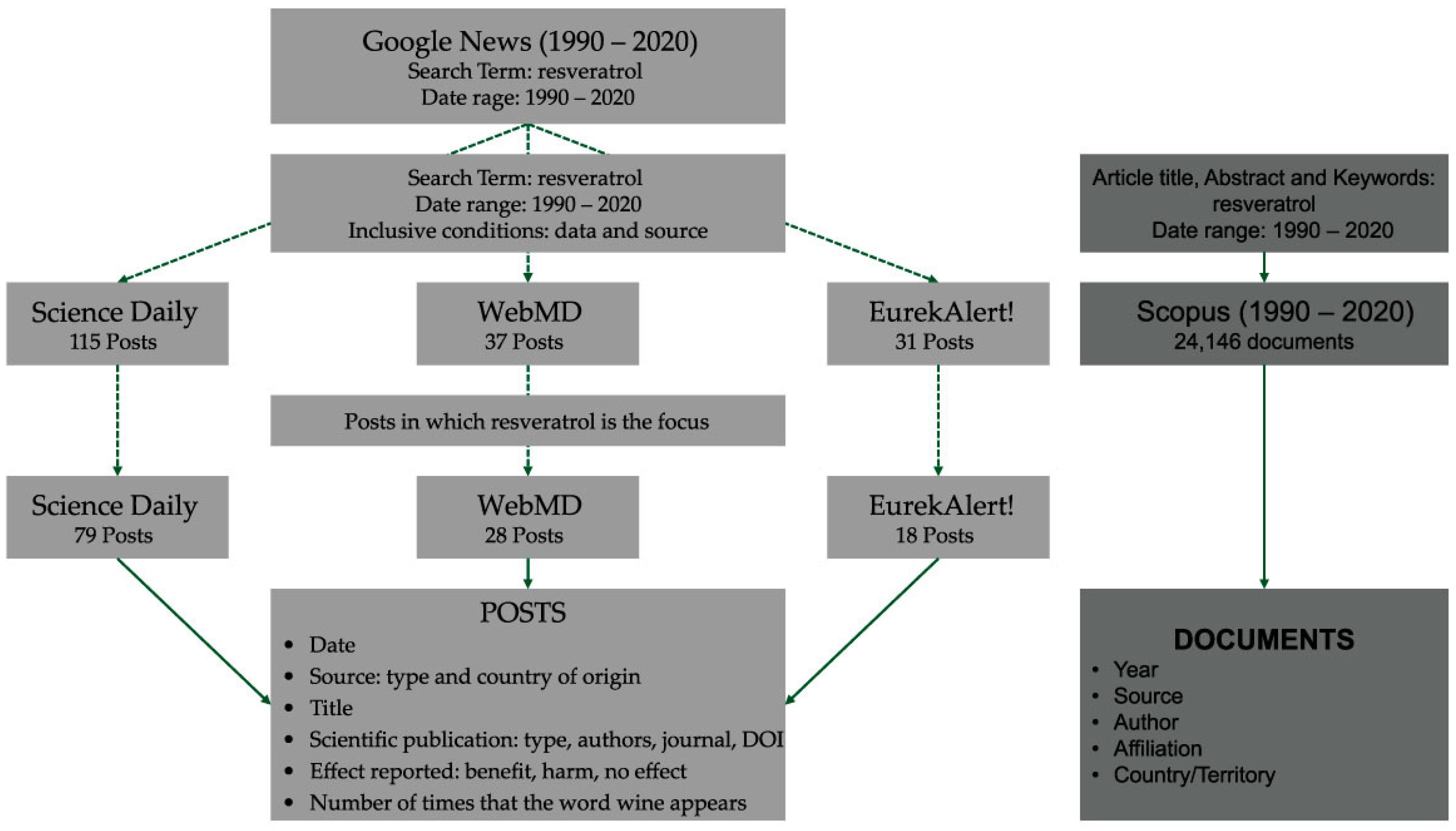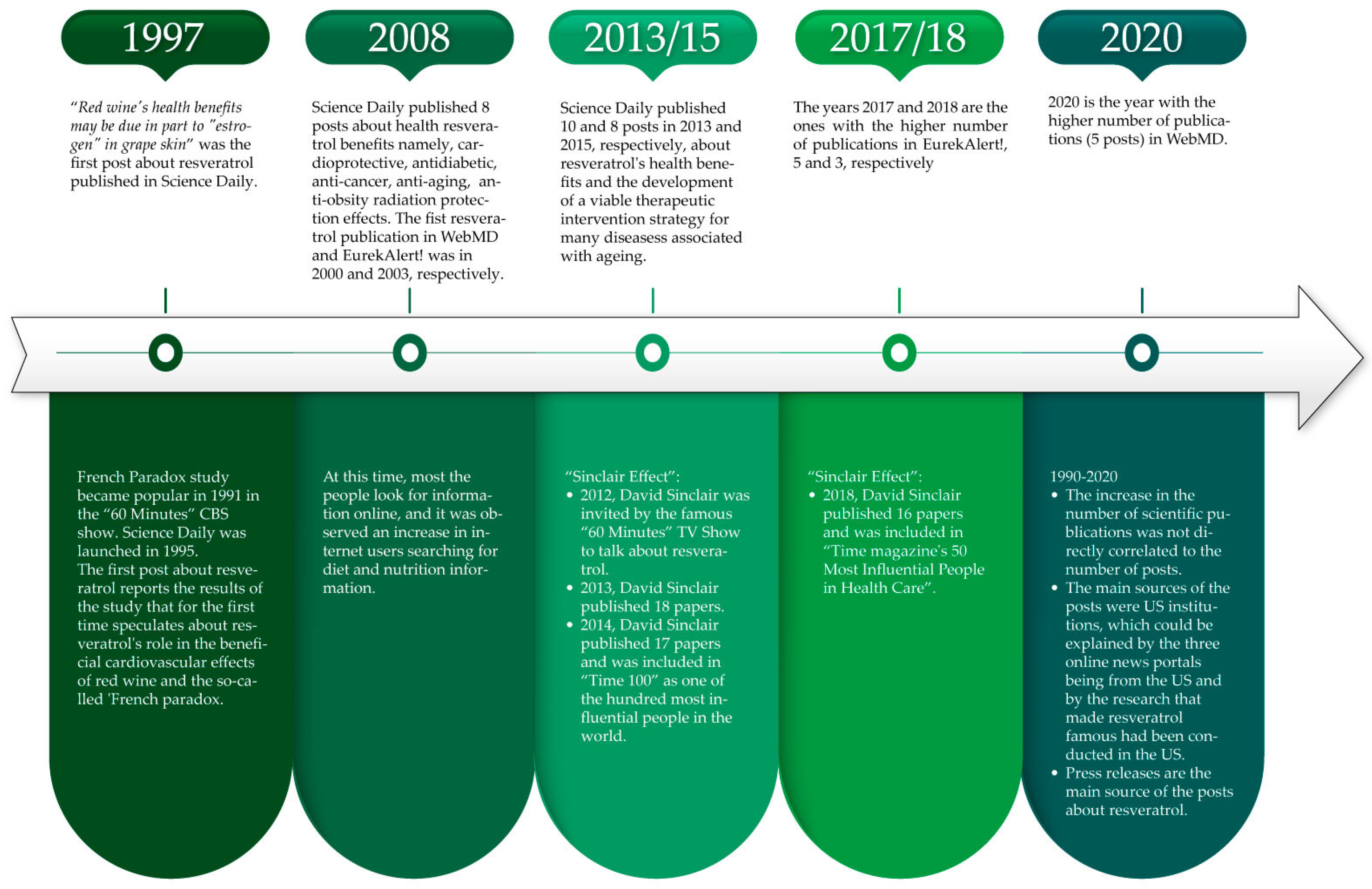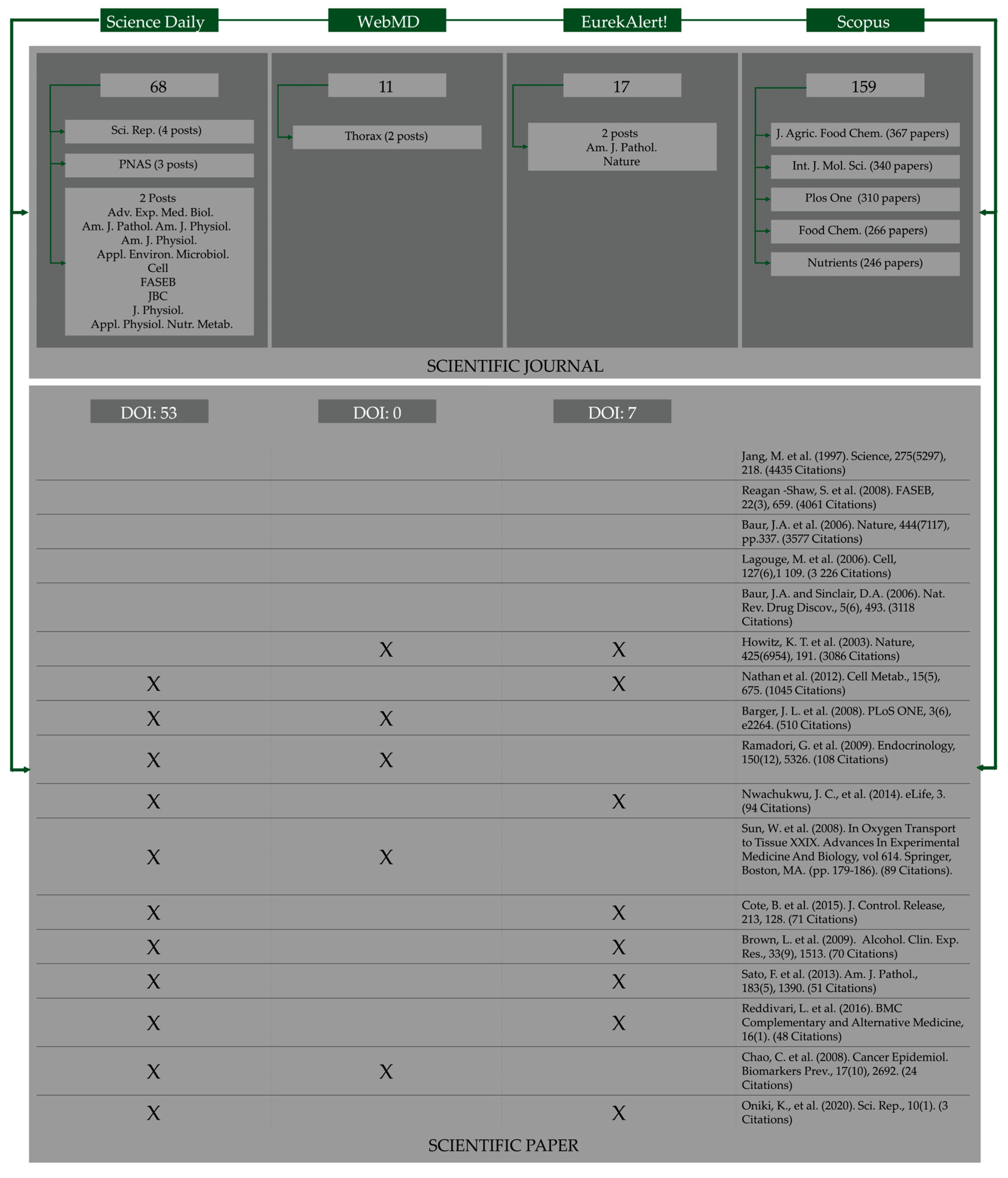Resveratrol and Wine: An Overview of Thirty Years in the Digital News
Abstract
1. Introduction
2. Materials and Methods
3. Results and Discussion
3.1. Resveratrol in the Digital News
3.2. Scientific Evidence for and Against
4. Conclusions
Author Contributions
Funding
Institutional Review Board Statement
Informed Consent Statement
Data Availability Statement
Conflicts of Interest
References
- Van Liedekerke, L. Media ethics: From corporate governance to governance, to corporate social responsibility. Communications 2004, 29, 27–42. [Google Scholar] [CrossRef]
- Briñol, P.; Petty, R.E. Elaboration and validation processes: Implications for media attitude change. Media Psychol. 2015, 18, 267–291. [Google Scholar] [CrossRef]
- Maeseele, P. On media and science in late modern societies. Ann. Int. Commun. Assoc. 2013, 37, 181–208. [Google Scholar] [CrossRef]
- Macgregor, S.; Cooper, A.; Coombs, A.; Deluca, C. A scoping review of co-production between researchers and journalists in research communication. Heliyon 2020, 6, e04836. [Google Scholar] [CrossRef]
- Carvalho, A. Política, cidadania e comunicação “crítica” da ciência. Comun. Soc. 2004, 6, 35–49. [Google Scholar] [CrossRef]
- Brandtzæg, P.B.; Heim, J.; Karahasanović, A. Understanding the new digital divide—A typology of Internet users in Europe. Int. J. Hum. Comput. Stu. 2011, 69, 123–138. [Google Scholar] [CrossRef]
- Coyne, S.M.; Padilla-Walker, L.M.; Howard, E. Emerging in a digital world: A decade review of media use, effects, and gratifications in emerging adulthood. Emerg. Adulthood 2013, 1, 125–137. [Google Scholar] [CrossRef]
- Vercellesi, L.; Minghetti, P.; Di Croce, M.; Bazzi, A.; Pieroni, B.; Centemeri, C.; Bruno, F. Recommendations for health reporting: Proposal of a working paper. Health Educ. J. 2010, 69, 48–62. [Google Scholar] [CrossRef]
- Steensen, S. Online journalism and the promises of new technology: A critical review and look ahead. J. Stud. 2011, 12, 311–327. [Google Scholar] [CrossRef]
- Schäfer, M.S. How changing media structures are affecting science news coverage. In The Oxford Handbook of the Science of Science Communication; Oxford University Press: Oxford, UK, 2017; Volume 51, p. 57. [Google Scholar]
- Yavchitz, A.; Boutron, I.; Bafeta, A.; Marroun, I.; Charles, P.; Mantz, J.; Ravaud, P. Misrepresentation of randomized controlled trials in press releases and news coverage: A cohort study. PLoS Med. 2012, 9, e1001308. [Google Scholar] [CrossRef]
- Haneef, R.; Lazarus, C.; Ravaud, P.; Yavchitz, A.; Boutron, I. Interpretation of results of studies evaluating an intervention highlighted in Google Health News: A cross-sectional study of news. PLoS ONE 2015, 10, e0140889. [Google Scholar] [CrossRef] [PubMed]
- Ramsay, M.E. Measles: The legacy of low vaccine coverage. Arch. Dis. Child. 2013, 98, 752–754. [Google Scholar] [CrossRef] [PubMed][Green Version]
- Sumner, P.; Vivian-Griffiths, S.; Boivin, J.; Williams, A.; Bott, L.; Adams, R.; Venetis, C.A.; Whelan, L.; Hughes, B.; Chambers, C.D. Exaggerations and caveats in press releases and health-related science news. PLoS ONE 2016, 11, e0168217. [Google Scholar] [CrossRef] [PubMed]
- Chiu, K.; Grundy, Q.; Bero, L. ‘Spin’ in published biomedical literature: A methodological systematic review. PLoS Biol. 2017, 15, e2002173. [Google Scholar] [CrossRef]
- Sumner, P.; Vivian-Griffiths, S.; Boivin, J.; Williams, A.; Venetis, C.A.; Davies, A.; Ogden, J.; Whelan, L.; Hughes, B.; Dalton, B.; et al. The association between exaggeration in health related science news and academic press releases: Retrospective observational study. BMJ 2014, 349, g7015. [Google Scholar] [CrossRef]
- Takaoka, M.J. Of the phenolic substances of white hellebore (Veratrum grandiflorum Loes. fil.). J. Fac.Sci. Hokkaido Univ. 1940, 3, 1–16. [Google Scholar] [CrossRef]
- King, R.E.; Bomser, J.A.; Min, D.B. Bioactivity of resveratrol. Compr. Rev. Food Sci. Food Saf. 2006, 5, 65–70. [Google Scholar] [CrossRef]
- Nonomura, S.; Kanagawa, H.; Makimoto, A. Chemical constituents of polygonaceous plants. I. Studies on the components of ko-j-o-kon. (Polygonum cuspidatum SIEB. et ZUCC.). J. Pharm Soc. Jpn. 1963, 83, 988–990. [Google Scholar] [CrossRef]
- Langcake, P.; Pryce, R. The production of resveratrol by Vitis vinifera and other members of the Vitaceae as a response to infection or injury. Physiol. Plant Pathol. 1976, 9, 77–86. [Google Scholar] [CrossRef]
- Siemann, E.; Creasy, L. Concentration of the phytoalexin resveratrol in wine. Am. J. Enol. Vitic. 1992, 43, 49–52. [Google Scholar]
- Visioli, F.; Panaite, S.-A.; Tomé-Carneiro, J. Wine’s phenolic compounds and health: A pythagorean view. Molecules 2020, 25, 4105. [Google Scholar] [CrossRef] [PubMed]
- Renaud, S.; de Lorgeril, M. Wine, alcohol, platelets, and the French paradox for coronary heart disease. Lancet 1992, 339, 1523–1526. [Google Scholar] [CrossRef] [PubMed]
- Snopek, L.; Mlcek, J.; Sochorova, L.; Baron, M.; Hlavacova, I.; Jurikova, T.; Kizek, R.; Sedlackova, E.; Sochor, J. Contribution of red wine consumption to human health protection. Molecules 2018, 23, 1684. [Google Scholar] [CrossRef] [PubMed]
- Nunes, S.; Danesi, F.; Del Rio, D.; Silva, P. Resveratrol and inflammatory bowel disease: The evidence so far. Nutr. Res. Rev. 2018, 31, 85–97. [Google Scholar] [CrossRef]
- Silva, P.; Fernandes, E.; Carvalho, F. Dual effect of red wine on liver redox status: A concise and mechanistic review. Arch. Toxicol. 2015, 89, 1681–1693. [Google Scholar] [CrossRef]
- Silva, P.; Latruffe, N.; de Gaetano, G. Wine consumption and oral cavity cancer: Friend or foe, two faces of janus. Molecules 2020, 25, 2569. [Google Scholar] [CrossRef] [PubMed]
- Silva, P.; Rodríguez-Pérez, M.; Gómez-Torres, Ó.; Burgos-Ramos, E. Olive oil and wine as source of multi-target agents in the prevention of Alzheimer disease. Nutr. Res. Rev. 2021, 1–15. [Google Scholar] [CrossRef]
- Silva, P.; Sureda, A.; Tur, J.A.; Andreoletti, P.; Cherkaoui-Malki, M.; Latruffe, N. How efficient is resveratrol as an antioxidant of the Mediterranean diet, towards alterations during the aging process? Free Radic. Res. 2019, 53, 1101–1112. [Google Scholar] [CrossRef]
- Wiley, J.; Rayner, K. Effects of titles on the processing of text and lexically ambiguous words: Evidence from eye movements. Mem. Cogn. 2000, 28, 1011–1021. [Google Scholar] [CrossRef]
- Gehm, B.D.; McAndrews, J.M.; Chien, P.-Y.; Jameson, J.L. Resveratrol, a polyphenolic compound found in grapes and wine, is an agonist for the estrogen receptor. Proc. Natl. Acad. Sci. USA 1997, 94, 14138–14143. [Google Scholar] [CrossRef]
- Spaak, J.; Merlocco, A.C.; Soleas, G.J.; Tomlinson, G.; Morris, B.L.; Picton, P.; Notarius, C.F.; Chan, C.T.; Floras, J.S. Dose-related effects of red wine and alcohol on hemodynamics, sympathetic nerve activity, and arterial diameter. Am. J. Physiol. Heart Circ. 2008, 294, H605–H612. [Google Scholar] [CrossRef] [PubMed]
- Leifert, W.R.; Abeywardena, M.Y. Grape seed and red wine polyphenol extracts inhibit cellular cholesterol uptake, cell proliferation, and 5-lipoxygenase activity. Nutr. Res. 2008, 28, 842–850. [Google Scholar] [CrossRef]
- Lu, C.; Bambang, I.F.; Armstrong, J.S.; Whiteman, M. Resveratrol blocks high glucose-induced mitochondrial reactive oxygen species production in bovine aortic endothelial cells: Role of phase 2 enzyme induction? Diabetes Obes. Metab. 2008, 10, 347–349. [Google Scholar] [CrossRef] [PubMed]
- Sun, W.; Wang, W.; Kim, J.; Keng, P.; Yang, S.; Zhang, H.; Liu, C.; Okunieff, P.; Zhang, L. Anti-cancer effect of resveratrol is associated with induction of apoptosis via a mitochondrial pathway alignment. In Oxygen Transport to Tissue XXIX; Springer: Boston, MA, USA, 2008; pp. 179–186. [Google Scholar]
- Chao, C.; Slezak, J.M.; Caan, B.J.; Quinn, V.P. Alcoholic beverage intake and risk of lung cancer: The California men’s health study. Cancer Epidemiol. Biomark. Prev. 2008, 17, 2692–2699. [Google Scholar] [CrossRef]
- Barger, J.L.; Kayo, T.; Vann, J.M.; Arias, E.B.; Wang, J.; Hacker, T.A.; Wang, Y.; Raederstorff, D.; Morrow, J.D.; Leeuwenburgh, C.; et al. A low dose of dietary resveratrol partially mimics caloric restriction and retards aging parameters in mice. PLoS ONE 2008, 3, e2264. [Google Scholar] [CrossRef]
- Koide, K.; Osman, S.; Garner, A.L.; Song, F.; Dixon, T.; Greenberger, J.S.; Epperly, M.W. The use of 3,5,4-tri-O-acetylresveratrol as a potential prodrug for resveratrol protects mice from γ-irradiation-induced death. ACS Med. Chem. Lett. 2011, 2, 270–274. [Google Scholar] [CrossRef]
- Ybarra, M.; Suman, M. Reasons, assessments and actions taken: Sex and age differences in uses of Internet health information. Health Educ. Res. 2008, 23, 512–521. [Google Scholar] [CrossRef] [PubMed]
- Suggs, L.S.; McIntyre, C. Are We There Yet? An examination of online tailored health communication. Health Educ. Behav. 2009, 36, 278–288. [Google Scholar] [CrossRef]
- Gomes, A.P.; Price, N.L.; Ling, A.J.; Moslehi, J.J.; Montgomery, M.K.; Rajman, L.; White, J.P.; Teodoro, J.S.; Wrann, C.D.; Hubbard, B.P.; et al. Declining NAD+ induces a pseudohypoxic state disrupting nuclear-mitochondrial communication during aging. Cell 2013, 155, 1624–1638. [Google Scholar] [CrossRef]
- Martin-Montalvo, A.; Mercken, E.M.; Mitchell, S.J.; Palacios, H.H.; Mote, P.L.; Scheibye-Knudsen, M.; Gomes, A.P.; Ward, T.M.; Minor, R.K.; Blouin, M.-J.; et al. Metformin improves healthspan and lifespan in mice. Nat. Comun. 2013, 4, 2192. [Google Scholar] [CrossRef]
- Hubbard, B.P.; Gomes, A.P.; Dai, H.; Li, J.; Case, A.W.; Considine, T.; Riera, T.V.; Lee, J.E.; Yen, E.S.; Lamming, D.W.; et al. Evidence for a common mechanism of SIRT1 regulation by allosteric activators. Science 2013, 339, 1216–1219. [Google Scholar] [CrossRef] [PubMed]
- Roberts, V.H.J.; Pound, L.D.; Thorn, S.R.; Gillingham, M.B.; Thornburg, K.L.; Friedman, J.E.; Frias, A.E.; Grove, K.L. Beneficial and cautionary outcomes of resveratrol supplementation in pregnant nonhuman primates. FASEB J. 2014, 28, 2466–2477. [Google Scholar] [CrossRef] [PubMed]
- Yoshino, J.; Conte, C.; Fontana, L.; Mittendorfer, B.; Imai, S.; Schechtman, K.B.; Gu, C.; Kunz, I.; Fanelli, F.R.; Patterson, B.W.; et al. Resveratrol supplementation does not improve metabolic function in nonobese women with normal glucose tolerance. Cell Metab. 2012, 16, 658–664. [Google Scholar] [CrossRef] [PubMed]
- Briansó-Llort, L.; Simó-Servat, O.; Ramos-Perez, L.; Torres-Torronteras, J.; Hernandez, C.; Simó, R.; Selva, D.M. Effect of resveratrol content in red wine on circulating sex hormone-binding globulin: Lessons from a pilot clinical trial. Mol. Nutr. Food Res. 2022, 66, e2200125. [Google Scholar] [CrossRef]
- Roggerio, A.; Cassaro Strunz, C.M.; Pacanaro, A.P.; Leal, D.P.; Takada, J.Y.; Avakian, S.D.; de Padua Mansur, A. Gene expression of sirtuin-1 and endogenous secretory receptor for advanced glycation end products in healthy and slightly overweight subjects after caloric restriction and resveratrol administration. Nutrients 2018, 10, 937. [Google Scholar] [CrossRef]
- Malaguti, M.; Angeloni, C.; Hrelia, S. Polyphenols in exercise performance and prevention of exercise-induced muscle damage. Oxid. Med. Cell. Long. 2013, 2013, 825928. [Google Scholar] [CrossRef]
- Belviranli, M.; Okudan, N. Well-known antioxidants and newcomers in sport nutrition: Coenzyme Q10, quercetin, resveratrol, pterostilbene, pycnogenol and astaxanthin. In Antioxidants in Sport Nutrition; Lamprecht, M., Ed.; CRC Press/Taylor & Francis: Boca Raton, FL, USA, 2015; Chapter 5. [Google Scholar]
- Mankowski, R.T.; Anton, S.D.; Buford, T.W.; Leeuwenburgh, C. Dietary antioxidants as modifiers of physiologic adaptations to exercise. Med. Sci. Sports Exerc. 2015, 47, 1857–1868. [Google Scholar] [CrossRef]
- Baltaci, S.B.; Mogulkoc, R.; Baltaci, A.K. Resveratrol and exercise. Biomed. Rep. 2016, 5, 525–530. [Google Scholar] [CrossRef]
- da Fonseca, L.M.; de Souza, J.A.; Santos, I.W.; Ferreira, R.S.; Alvarez, N.M.; Ferreira, B.; Dolisnky, M.; do Carmo, F.L.; Girão, S.; Soares, C.A.; et al. Beverages rich in resveratrol and physical activity attenuate metabolic changes induced by high-fat diet. J. Am. Coll. Nutr. 2021, 40, 485–495. [Google Scholar] [CrossRef]
- Vinson, J.A.; Teufel, K.; Wu, N. Red wine, dealcoholized red wine, and especially grape juice, inhibit atherosclerosis in a hamster model. Atherosclerosis 2001, 156, 67–72. [Google Scholar] [CrossRef]
- Dolinsky, V.W.; Jones, K.E.; Sidhu, R.S.; Haykowsky, M.; Czubryt, M.P.; Gordon, T.; Dyck, J.R.B. Improvements in skeletal muscle strength and cardiac function induced by resveratrol during exercise training contribute to enhanced exercise performance in rats. J. Physiol. 2012, 590, 2783–2799. [Google Scholar] [CrossRef] [PubMed]
- Hart, N.; Sarga, L.; Csende, Z.; Koltai, E.; Koch, L.G.; Britton, S.L.; Davies, K.J.A.; Kouretas, D.; Wessner, B.; Radak, Z. Resveratrol enhances exercise training responses in rats selectively bred for high running performance. Food Chem. Toxicol. 2013, 61, 53–59. [Google Scholar] [CrossRef] [PubMed]
- Wu, R.E.; Huang, W.-C.; Liao, C.-C.; Chang, Y.-K.; Kan, N.-W.; Huang, C.-C. Resveratrol protects against physical fatigue and improves exercise performance in mice. Molecules 2013, 18, 4689–4702. [Google Scholar] [CrossRef]
- Kan, N.-W.; Ho, C.-S.; Chiu, Y.-S.; Huang, W.-C.; Chen, P.-Y.; Tung, Y.-T.; Huang, C.-C. Effects of resveratrol supple-mentation and exercise training on exercise performance in middle-aged mice. Molecules 2016, 21, 661. [Google Scholar] [CrossRef]
- Kan, N.-W.; Lee, M.-C.; Tung, Y.-T.; Chiu, C.-C.; Huang, C.-C.; Huang, W.-C. The synergistic effects of resveratrol combined with resistant training on exercise performance and physiological adaption. Nutrients 2018, 10, 1360. [Google Scholar] [CrossRef]
- Huang, C.-C.; Lee, M.-C.; Ho, C.-S.; Hsu, Y.-J.; Ho, C.-C.; Kan, N.-W. Protective and recovery effects of resveratrol supplementation on exercise performance and muscle damage following acute plyometric exercise. Nutrients 2021, 13, 3217. [Google Scholar] [CrossRef]
- Tsao, J.-P.; Liu, C.-C.; Wang, H.-F.; Bernard, J.R.; Huang, C.-C.; Cheng, I.-S. Oral resveratrol supplementation attenuates exercise-induced interleukin-6 but not oxidative stress after a high intensity cycling challenge in adults. Int. J. Med. Sci. 2021, 18, 2137–2145. [Google Scholar] [CrossRef] [PubMed]
- Sato, F.; Martinez, N.E.; Shahid, M.; Rose, J.W.; Carlson, N.G.; Tsunoda, I. Resveratrol exacerbates both autoimmune and viral models of multiple sclerosis. Am. J. Pathol. 2013, 183, 1390–1396. [Google Scholar] [CrossRef] [PubMed]
- Maurya, S.K.; Bhattacharya, N.; Mishra, S.; Bhattacharya, A.; Banerjee, P.; Senapati, S.; Mishra, R. Microglia specific drug targeting using natural products for the regulation of redox imbalance in neurodegeneration. Front. Pharmacol. 2021, 12, 654489. [Google Scholar] [CrossRef]
- Schwartz, L.M.; Woloshin, S.; Andrews, A.; Stukel, T.A. Influence of medical journal press releases on the quality of associated newspaper coverage: Retrospective cohort study. BMJ 2012, 344, d8164. [Google Scholar] [CrossRef]



| Scientific Paper Authors | Science Daily | WebMD | EurekAlert! | Total |
|---|---|---|---|---|
| First | 11 | 3 | 3 | 17 |
| Middle (all or some) | 2 | 2 | 2 | 6 |
| Last | 39 | 2 | 5 | 46 |
| First and Middle (some) | 0 | 0 | 0 | 0 |
| Middle (some) and Last | 4 | 0 | 2 | 6 |
| First, Middle (some) and Last | 4 | 0 | 0 | 4 |
| First and Last | 9 | 0 | 2 | 11 |
| All authors | 3 | 0 | 4 | 7 |
| The person(s) mentioned is (are) not authors | 5 | 11 | 0 | 16 |
| No one is mentioned | 2 | 19 | 0 | 21 |
| Total of Posts | 79 | 37 | 18 |
Publisher’s Note: MDPI stays neutral with regard to jurisdictional claims in published maps and institutional affiliations. |
© 2022 by the authors. Licensee MDPI, Basel, Switzerland. This article is an open access article distributed under the terms and conditions of the Creative Commons Attribution (CC BY) license (https://creativecommons.org/licenses/by/4.0/).
Share and Cite
Silva, P.; Portillo, M.P.; Fernández-Quintela, A. Resveratrol and Wine: An Overview of Thirty Years in the Digital News. Int. J. Environ. Res. Public Health 2022, 19, 15815. https://doi.org/10.3390/ijerph192315815
Silva P, Portillo MP, Fernández-Quintela A. Resveratrol and Wine: An Overview of Thirty Years in the Digital News. International Journal of Environmental Research and Public Health. 2022; 19(23):15815. https://doi.org/10.3390/ijerph192315815
Chicago/Turabian StyleSilva, Paula, María P. Portillo, and Alfredo Fernández-Quintela. 2022. "Resveratrol and Wine: An Overview of Thirty Years in the Digital News" International Journal of Environmental Research and Public Health 19, no. 23: 15815. https://doi.org/10.3390/ijerph192315815
APA StyleSilva, P., Portillo, M. P., & Fernández-Quintela, A. (2022). Resveratrol and Wine: An Overview of Thirty Years in the Digital News. International Journal of Environmental Research and Public Health, 19(23), 15815. https://doi.org/10.3390/ijerph192315815








